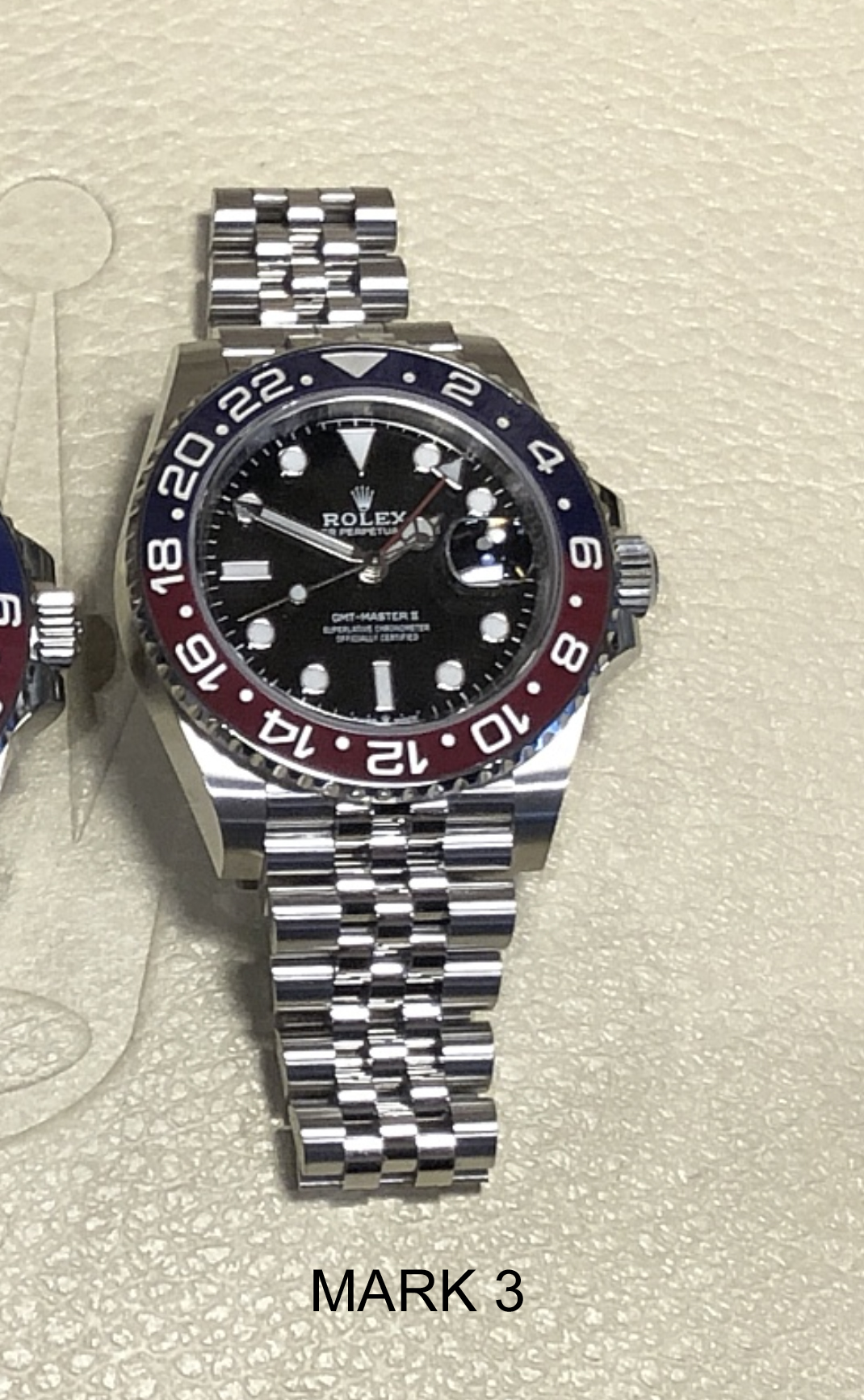The difference between the Rolex GMT Master II 126710 BLRO Pepsi MK1 and the new GMT Master II 126710 BLRO Pepsi MK2 is the ceramic bezel.
The MK1's bezel is more pinkish, almost a fresco of color, much more sought-after because it has created a patinated hue, the blue is more diluted and the red less vivid (almost clay-like!).
The MK1 PESPI was marketed over just a few months when it was launched at Baselworld 2018.
Some say the Rolex bezel comes directly from the GMT PESPI 116719BLRO white gold model on Oyster bracelet released at Baselworld 2014....Why not ?
These are not details to which I attach much importance. There are several versions of the famous Rolex GMT-Master II 126710 BLRO, hence the (obviously unofficial) use of the terminologies Mk1, Mk2 and Mk3. The differences are due to the treatment of the bezel colors, which evolve according to the version. In fact, these vintages can be broken down as follows:
the first watches delivered in 2018 have a bezel with shallower colors, with blue tending towards violet and red towards pink, depending on lighting conditions
then, very quickly, the next watches offer a bezel with darker, more intense colors
finally, the latest deliveries change again, with a blue that tends even more towards midnight blue, giving the impression that the Pepsi bezel is converging with the Coke bezel.
The differences become apparent when the three versions are placed side by side, but you need to have the opportunity to see them at the same time. The differences are clear between Mk1 and Mk2, and more subtle between Mk2 and Mk3.
These observations lead me to the following personal reflections:
only Rolex generates such observations. This is the fascinating or irritating side of the brand... and it's not due to the brand, but to its fans. It goes without saying that Rolex does not communicate on this point, nor does it dwell on these details in its communications.
In any case, these color changes demonstrate the complexity of manufacturing the blue-red ceramic bezel. The drop-out rate is said to be high, with Rolex rejecting a large number of bezels in order to select one that meets the quality criteria. The evolution of the colors may reflect a change in process after the use of the white gold version of the bezel in the MK1 version.
the manufacture of the blue and black ceramic bezel is simpler and more controlled. In fact, it was already available with the previous steel model, the 116710 BLNR.
In my opinion, this would help explain why Rolex is presenting a 126710 Batman in 2019, just one year after the 126710 Pepsi. It's not just a desire to extend the choice of colors. There's also an industrial logic behind it. So I think there will be far more 126710 Batmans "in circulation" than 126710 Pepsis.
It all sounds very anecdotal. But here we are in a Rolex context, and in that of one of its most famous watches. These minute details could later become important and generate different ratings for different versions. But these reflections can also be swept away in the blink of an eye if Rolex again uses a bezel that's supposed to have been replaced, or if volumes increase. In short, we're more in the realm of guesswork than scientific rigor. However, only Rolex can encourage us to analyze such details. And let's be clear: I would never have written these lines if they had concerned any other brand. That's how Rolex magic works.
The photos show 3 x variants: from the lightest (the oldest) to the darkest (the most recent). Here are a few photos to give you an idea:






 Rolex Vintage Chronometer Red Hang Seal Tag CERTIFIED OFFICIAL CHRONOMETER
Rolex Vintage Chronometer Red Hang Seal Tag CERTIFIED OFFICIAL CHRONOMETER
 REFERENCING ROLEX GLASSES BY MODELS CLASSIFICATION
REFERENCING ROLEX GLASSES BY MODELS CLASSIFICATION
 Rolex Gmt Master 126710 Differences Pepsi bezels variations colors Marks
Rolex Gmt Master 126710 Differences Pepsi bezels variations colors Marks